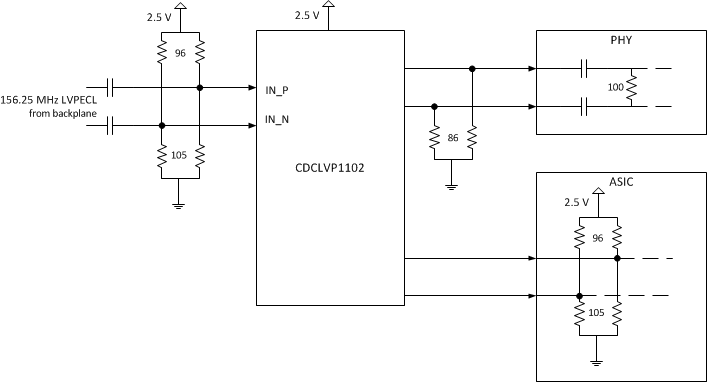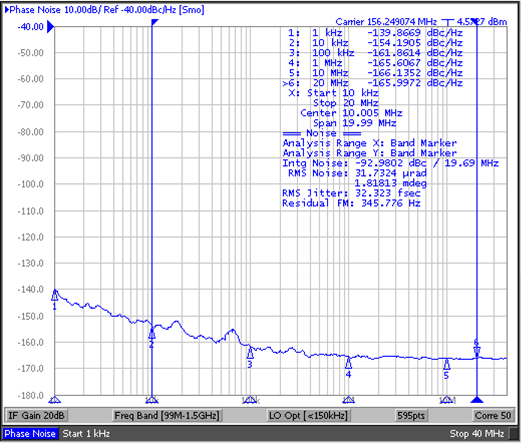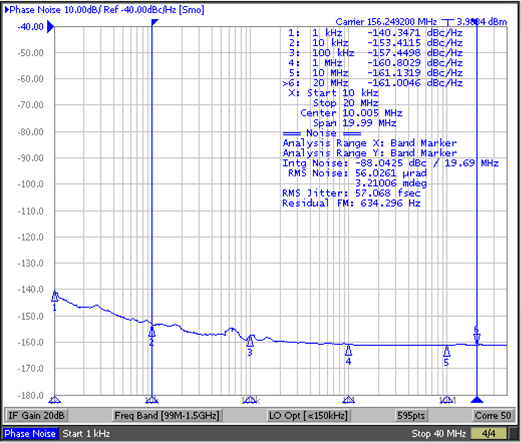SCAS884D August 2009 – December 2015 CDCLVP1102
PRODUCTION DATA.
- 1 Features
- 2 Applications
- 3 Description
- 4 Revision History
- 5 Pin Configuration and Functions
-
6 Specifications
- 6.1 Absolute Maximum Ratings
- 6.2 ESD Ratings
- 6.3 Recommended Operating Conditions
- 6.4 Thermal Information
- 6.5 Electrical Characteristics: LVCMOS Input
- 6.6 Electrical Characteristics: Differential Input
- 6.7 Electrical Characteristics: LVPECL Output
- 6.8 Electrical Characteristics: LVPECL Output
- 6.9 Typical Characteristics
- 7 Parameter Measurement Information
- 8 Detailed Description
- 9 Application and Implementation
- 10Power Supply Recommendations
- 11Layout
- 12Device and Documentation Support
- 13Mechanical, Packaging, and Orderable Information
9 Application and Implementation
NOTE
Information in the following applications sections is not part of the TI component specification, and TI does not warrant its accuracy or completeness. TI’s customers are responsible for determining suitability of components for their purposes. Customers should validate and test their design implementation to confirm system functionality.
9.1 Application Information
The CDCLVP1102 is a low additive jitter LVPECL fanout buffer that can generate two copies of a LVPECL, LVDS, or LVCMOS input. The CDCLVP1102 can accept reference clock frequencies up to 2 GHz while providing low output skew.
9.2 Typical Application
9.2.1 Fanout Buffer for Line Card Application
 Figure 20. CDCLVP1102 Typical Application
Figure 20. CDCLVP1102 Typical Application
9.2.1.1 Design Requirements
The CDCLVP1102 shown in Figure 20 is configured to receive a 156.25-MHz LVPECL clock from the backplane. Either signal can be then fanned out to desired devices, as shown. The configuration example is driving 2 LVPECL receivers in a line card application with the following properties:
- The PHY device has internal AC coupling and appropriate termination and biasing. The CDCLVP1102 will need to be provided with 86-Ω emitter resistors near the driver for proper operation.
- The ASIC is capable of DC coupling with a 2.5-V LVPECL driver such as the CDCLVP1102. This ASIC features internal termination so no additional components are needed.
9.2.1.2 Detailed Design Procedure
Refer to Input Termination for proper input terminations, dependent on single ended or differential inputs.
Refer to LVPECL Output Termination for output termination schemes depending on the receiver application. Unused outputs can be left floating.
In this example, the PHY, ASIC, and FPGA/CPU require different schemes. Power supply filtering and bypassing is critical for low noise applications.
See Power Supply Recommendations for recommended filtering techniques. A reference layout is provided on the CDCLVP1102 Evaluation Module at SCAU035.
9.2.1.3 Application Curves
The CDCLVP1102's low additive noise can be shown in this line card application. The low noise 156.25 MHz XO with 32-fs RMS jitter drives the CDCLVP1102, resulting in 57-fs RMS when integrated from 10 kHz to 20 MHz. The resultant additive jitter is a low 47-fs RMS for this configuration.

